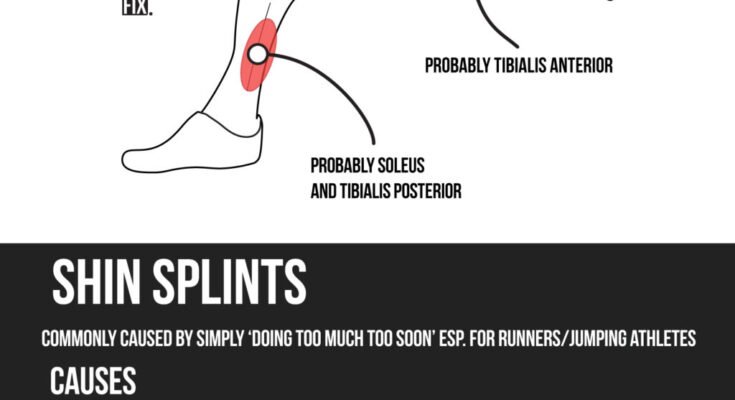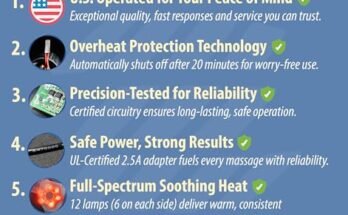Shin splints can be a real pain, literally. If you’ve ever felt that aching sensation along your shin, you know how it can slow you down and make even simple tasks uncomfortable.
You might be wondering if there’s a solution to ease the discomfort and get back on your feet quickly. What if a massage could be your answer? Imagine the relief, the soothing touch that might help you feel better. But before you reach for the nearest massage oil, it’s crucial to know if massaging shin splints is truly beneficial or could potentially cause more harm.
Stay with us as we explore whether this popular technique can really help you find relief and get back to your active lifestyle.
Causes Of Shin Splints
Shin splints are a common issue for many athletes and active individuals. The pain and discomfort originate from the shinbone area. Understanding the causes of shin splints can help in managing and preventing them. Knowing what triggers shin splints can also aid in effective treatment.
Common Triggers
Shin splints often result from overuse. Running is a frequent cause. Rapidly increasing workout intensity can lead to pain. Poor shoe support is another factor. Hard surfaces can increase the risk. Incorrect form during exercise may contribute. Stress on the lower leg muscles can cause inflammation. This leads to shin splints.
Impact On Athletes
Athletes are particularly vulnerable. The repetitive movements they perform can strain muscles. Shin splints can hinder training routines. Performance may suffer as pain persists. Rest and recovery are often required. This can impact their athletic goals. Understanding the causes helps in injury prevention.

Symptoms And Diagnosis
Shin splints cause pain in the lower leg, often due to overuse or improper footwear. Symptoms include swelling and tenderness along the shin. Proper diagnosis from a healthcare professional is crucial for effective treatment, which may include rest, ice, and gentle massage to reduce discomfort.
Understanding the symptoms and diagnosis of shin splints is crucial for effective treatment. If you’ve ever experienced that nagging pain along the front of your lower leg, you’re not alone. Many athletes and fitness enthusiasts face this issue. But how can you tell if it’s truly shin splints, and what steps should you take to confirm the diagnosis? Let’s dive into the key aspects of recognizing and diagnosing this common condition.Recognizing Shin Splints
Shin splints often start as a dull ache in the front part of the lower leg. You might notice this pain during or after physical activity. It can progress to a sharper pain if ignored. Swelling might also be present. You may feel tenderness along the inner part of your lower leg. For some, the area may even feel warm to the touch. Have you ever felt discomfort with each step or hop? That’s a common signal. Keep an eye on these symptoms to determine if they persist beyond your workout.Medical Evaluation
If these symptoms sound familiar, it’s wise to seek a medical evaluation. A healthcare provider can give you a definitive diagnosis. They may start by asking about your activity level and any recent changes in your routine. Physical examination is often the next step. This might involve checking for tenderness, swelling, or other signs of inflammation. Your doctor may also ask you to perform specific movements to assess pain levels. Sometimes, imaging tests like X-rays or MRIs are necessary. These can rule out stress fractures or other conditions that mimic shin splints. Have you thought about how a precise diagnosis can guide your treatment plan? It might be the difference between a quick recovery and prolonged discomfort. Understanding your symptoms and seeking a proper diagnosis is the first step towards recovery. Don’t let shin splints sideline your activities. Take action and consult a professional if you’re in doubt. What steps will you take today to address your concerns?Massage Therapy For Shin Splints
Massage therapy can ease shin splint pain by reducing muscle tension. It improves blood flow, promoting healing and relaxation. Consult a professional therapist for tailored care and relief.
Massage Therapy for Shin Splints Experiencing shin splints can be frustrating, especially if they sideline your running or sports activities. You might wonder if massage therapy could be the relief you need. The right massage techniques might not only ease your pain but also speed up your recovery. Imagine feeling the soothing touch of a therapist’s hands working on your sore shins. The immediate relaxation coupled with the relief from pain can be a game-changer. But how exactly does it work? Is there a particular massage technique that works best for shin splints? Let’s dive into some options.Types Of Massage Techniques
Different massage techniques can be utilized to target shin splints effectively. One popular method is deep tissue massage, which focuses on breaking down scar tissue and relieving muscle tightness. Another technique is sports massage, specifically tailored for athletes, concentrating on preventing and healing injuries. If you prefer something gentler, Swedish massage can help by improving circulation and reducing muscle tension in the shins. Have you ever tried self-massage? Using a foam roller or your hands, you can apply gentle pressure along the shin bone, which can help alleviate discomfort.Benefits Of Massage
Why should you consider massage therapy for shin splints? First, it can reduce inflammation in the affected area. By enhancing blood flow, massages can help your body heal faster. Additionally, massage therapy can alleviate pain. It releases endorphins, your body’s natural painkillers, providing much-needed relief without medication. Massage can also improve flexibility in your muscles. By relaxing the tight muscles around your shins, you might find a greater range of motion, making your physical activities more enjoyable. Have you noticed how stress often aggravates pain? Massage therapy can significantly reduce stress levels, giving you both physical and mental relief. So, is it good to massage shin splints? If you’re looking for a non-invasive, relaxing way to aid your recovery, massage therapy might just be the answer. Have you thought about incorporating it into your recovery routine?
Risks And Precautions
Massaging shin splints can offer relief. But it’s not without risks. Some individuals may not respond well to it. Knowing the risks helps you make informed choices. Always prioritize safety and well-being. Consider consulting a healthcare professional. This ensures that massage is appropriate for you.
Potential Side Effects
Massaging shin splints can cause discomfort. Over-massaging might worsen the pain. Bruising can occur if too much pressure is applied. Skin irritation is another potential side effect. Allergic reactions to massage oils are possible. Be aware of these risks before proceeding.
Who Should Avoid Massage
People with certain conditions should avoid massage. Those with fractures or broken bones should not receive massage. Individuals with deep vein thrombosis should also avoid it. If you have an infection in the area, skip the massage. Pregnant women should consult their doctor first. Those with severe osteoporosis should be cautious. Always seek professional advice before deciding.
Alternative Treatments
Massaging shin splints can relieve pain and improve recovery. It helps increase blood flow to the affected area. This technique may reduce muscle tightness and inflammation. Always consult a professional before starting treatment.
Massage therapy can aid in relieving shin splints. Its benefits are well-known. But it’s not the only method available for treating this condition. Alternative treatments provide various options. These can be beneficial for those seeking relief from shin splints. Let’s explore some effective alternatives.Physical Therapy
Physical therapy offers targeted exercises. These exercises strengthen muscles and improve flexibility. Therapists create personalized plans. Each plan focuses on the individual’s needs. This helps in reducing pain and preventing future injuries. Sessions often include stretching exercises. These exercises target specific areas around the shin. This can alleviate tension and promote healing.Home Remedies
Home remedies are accessible and easy. One popular method is rest. Giving your legs a break helps them heal. Ice therapy is another choice. Apply ice packs to the shins. This reduces swelling and numbs pain. Compression sleeves can be beneficial. They support the muscles and enhance blood flow. Elevating the legs also helps. It reduces swelling and discomfort. Combining these methods might provide relief. They are simple and cost-effective.
Preventing Shin Splints
Shin splints can be a real pain, quite literally, for anyone who loves to run or engage in physical activities. Preventing them is often easier than dealing with them once they occur. By making small changes to your exercise routine and footwear, you can keep these pesky pains at bay.
Exercise Modifications
Adjusting your workout can go a long way in preventing shin splints. If you’re a runner, consider adding rest days to your routine. Alternate between high-impact activities and low-impact exercises like swimming or cycling.
Strengthening exercises can also help. Incorporate exercises that focus on the lower leg muscles. Calf raises and toe taps are simple yet effective ways to build strength.
Have you ever noticed pain after increasing your running distance too quickly? Gradual progression is key. Increase your activity intensity and duration slowly to give your muscles time to adapt.
Proper Footwear
Your shoes play a critical role in supporting your feet and legs. Wearing the wrong type can lead to unnecessary stress on your shins. Choose footwear that offers good arch support and cushioning.
Consider visiting a specialty running store. They often provide gait analysis to help you find the perfect shoe for your foot type and running style. A pair of shoes might look great, but if they don’t fit well, they can do more harm than good.
How often do you replace your running shoes? It’s recommended to change them every 300-500 miles. Worn-out shoes lose their cushioning, which can contribute to shin splints.
By focusing on exercise modifications and proper footwear, you can significantly reduce your risk of developing shin splints. These small changes can make a big difference in your comfort and performance. So, what adjustments will you make to your routine to keep your shins in top shape?
Expert Opinions
Massaging shin splints can offer relief, though opinions differ. Experts suggest gentle techniques to ease pain and reduce inflammation. Seeking professional advice ensures safe and effective treatment for these common injuries.
Dealing with shin splints can be a frustrating experience for many. Whether you’re a seasoned athlete or someone who enjoys a casual jog, the pain can disrupt your routine. You might wonder if a massage could offer relief. Let’s dive into what the experts say about massaging shin splints and how athletes have benefited from it.What Health Professionals Say
Many physical therapists and sports medicine experts agree that massage can be beneficial for shin splints. They suggest that gentle massage can help reduce muscle tension and improve blood flow to the affected area. This can potentially speed up recovery. Doctors often recommend massage as a complementary treatment. It’s not a standalone solution but a part of a broader recovery plan. They emphasize the importance of combining massage with rest and proper footwear. Some experts caution against aggressive massage techniques. They warn that too much pressure can worsen inflammation. Always consult with a professional to ensure the massage is safe and effective for your condition.Testimonials From Athletes
Athletes often share personal success stories about using massage for shin splints. Many report feeling immediate relief after a session. This can boost your morale and keep you motivated to continue your training. One runner shared that regular massages helped them maintain their workout schedule. Instead of sidelining their routine, they found a way to manage their discomfort. This proactive approach allowed them to stay on track with their fitness goals. However, some athletes also caution against relying solely on massage. They highlight the importance of a holistic approach, including stretching and strengthening exercises. Addressing the root cause of shin splints is crucial for long-term success. Have you tried massage for your shin splints? If so, what was your experience? Sharing your story can help others in their journey to recovery.Frequently Asked Questions
Can Massage Help Relieve Shin Splints Pain?
Massage can help alleviate shin splints by reducing muscle tightness and improving circulation. It promotes healing and can decrease inflammation. Regular massage can also prevent future injuries and enhance recovery. Consult a professional to ensure proper technique and avoid worsening the condition.
Is Massage Effective For Shin Splints Recovery?
Massage is effective for shin splints recovery as it enhances blood flow and reduces muscle tension. It aids in faster healing and alleviates pain. Ensure the massage is done gently to avoid further irritation. Combine it with rest and stretching for optimal recovery results.
How Often Should You Massage Shin Splints?
Massaging shin splints two to three times a week is beneficial. Regular massage can accelerate healing and improve muscle flexibility. Adjust frequency based on pain levels and recovery progress. Consult with a therapist for personalized advice tailored to your specific needs and condition.
What Type Of Massage Is Best For Shin Splints?
Deep tissue massage is best for shin splints as it targets muscle knots and improves circulation. It releases tension and promotes healing. Ensure the massage is gentle and avoid applying excessive pressure. Consult a professional therapist for the most effective techniques tailored to your needs.
Conclusion
Massaging shin splints can offer relief. It helps reduce pain and tension. Always consult a healthcare professional first. Their advice ensures safe treatment. Regular massage can improve blood circulation. This aids healing and recovery. Pair massage with rest and proper footwear.
It maximizes benefits. Listen to your body and adjust as needed. Proper care leads to faster healing. Avoid over-massaging or intense pressure. It might worsen the condition. A balanced approach works best. Prioritize your comfort and health. This ensures effective recovery from shin splints.
Embrace gentle care for lasting relief.



